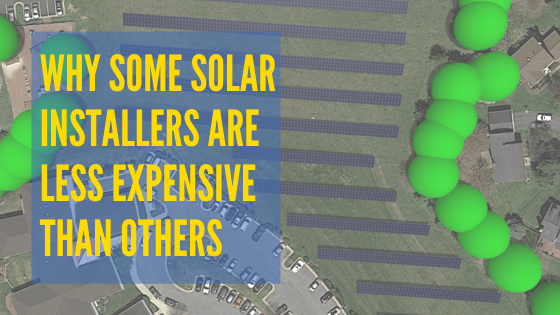You’re thinking about installing a solar system. As a savvy consumer, you do your due diligence, research reputable solar installers in your area, and get quotes from a few different companies.
Then, you meet with the consultants, the companies design your system, and the estimating teams have pulled together their proposals. All this has led up to one thing: that final number that shows how much going solar will cost you.
All your proposals may be in the same neighborhood, or they could have entirely different zip codes. If the latter is the case, these varied installation costs will probably leave you questioning why.
Huge variations in price during a bidding scenario certainly can set off some red flags. Even though they’re separate companies approaching your project a little differently, you’d expect them to be fairly similar. When they’re not, you need to find out why.
If you find yourself in this situation when comparing solar proposals, here are a few items to look into that could show you why one installer may be much more or less expensive than another.
Reasons why one solar installer may be more or less expensive than another
The System’s Design
Whether in person, on the phone, or online, you should have a conversation with a solar consultant from each company to discuss your electrical needs and your financial goals for your solar system.
During this conversation, you should talk about how much electricity you typically use (as told by your electric bill), how much of that usage you’d like to cover with solar, and any other preferences you have, such as the type of panels, inverters, if you’d like energy storage, and where the panels should be installed.
They’ll take this information and work with their team to layout a solar system that will fulfill your solar energy goals and that will work with your property.
Because each installation company may have a different approach to meeting your goals and designing your system, each system can be slightly different, which means they will vary in price. Differences in panel size (72-cell or 60-cell), the number of panels and/or inverters installed, and the location of the system can all impact the price of the system.
The System’s Size and Production
It’s very important to make sure you’re comparing apples to apples when reviewing the size and production of the proposed systems. These numbers often differ between proposals, and both can have a big impact on the price.
The system layout and the type of panel used are two factors that will impact the size and production. One installer might try to squeeze one or two panels into an area that another installer might not feel is fit for panels. Likewise, installers could be using different sized panels with varying production efficiency rates. All of which will have an impact on the price.
Shading can also have a big impact on the production of a system. Not all installers calculate shading the same and this could be the main factor behind why the kWh production of two similar-sized systems is different.
Another factor to consider is the type of inverter that’s being used. String inverters convert electricity for groups of panels which could cause some production loss if there is shading on any panel in the group. Microinverters are installed with each panel. This minimizes potential shading issues to just the shaded panel and not the entire group of panels.
The bottom line is you should scrutinize these differences and make sure to question your installer on their calculations so you understand the why behind them.
Quality of the Equipment Installed
Another variable in the price of solar installations is the type of equipment that your system is designed with. From inverters to batteries to the solar panels, there are many brands at many different price points. While it may be tempting to go with the budget brand to keep installation costs low, this could end up costing you more in the long run due to equipment replacements and/or lost productivity.
When it comes to solar panels, you want to be sure you end up with durable, efficient, high-quality panels that are backed by substantive manufacturer guarantees. Not only do these guarantees give you peace of mind, but they’re a measure of the quality of the panel.
Some of these manufacturers will guarantee their panels for up to 25, or even 30 years. Budget brands, on the other hand, may have much shorter warranties. So if something goes wrong with your panels a decade or two down the road, you won’t be able to get them replaced through the warranty.
Another major part of the solar system is the inverter, or inverters, depending on your system’s size and design. This is the part of your solar system that is most likely to fail first. Because of this, it’s important to go with quality over price. While a budget brand inverter may be easier upfront, the money you save likely won’t make up for having to install replacements more often than you if you went with a more reliable brand.
So when looking at your solar estimates, proposals, or quotes, be sure to take a look at the equipment your system is designed with. You should be provided with information on the equipment’s specification and warranties, so you’ll know if variables in installation price is due to the quality of solar equipment.
Additional Installer-Backed Warranties
Some solar installers may offer warranties in addition to those offered by the solar equipment manufacturer. These would include things like workmanship warranties and production warranties, which would also likely come with some sort of system monitoring.
These extra guarantees may cause a slight increase in the cost of your solar system, but they’ll also provide peace of mind and take some of the risks out of your solar investment.
In addition to that, some workmanship warranties, like Paradise Energy’s Triple Ten Guarantee, will cover the labor required to replace warranty items that were caused by a manufacturer’s issue. While manufacturer warranties cover the replacement of the actual product, the cost of the labor to install that product will be up to you, unless you’re backed by a warranty through your installer.
Then, there’s the production warranty. The way this works with Paradise Energy’s Triple Ten Guarantee is it will essentially guarantee the estimated electricity production on your solar proposal. So if we guarantee that your solar system will produce 50,000 kWhs the first year it’s installed, and it only produces 45,000 kWhs because it was an extremely cloudy year, we’ll pay you for the 5,000 kWhs of missed production. In order to make sure your solar system is producing what we guarantee, we’ll also monitor your system as part of the warranty.
These warranties are extremely valuable to solar owners, erasing many of the risks that come with installing solar. But just like well-guaranteed solar panels may cost a bit more, so too could well-guaranteed installation services. An installer who has comprehensive warranties may come back with a slightly higher installation cost, but that extra money will give you valuable guarantees that protect your investment.
Understanding Why Solar Installation Costs Vary
When reviewing your solar installation quotes, you’ll want to be sure you’re going with the option that is the best value. That means it pays off in the long term, even if it’s slightly more expensive initially. Understanding the system’s design, the quality of the equipment that’s installed, and the warranties the installer brings to the table can all help shed light on why one solar installer could be more expensive to install than another.
While it’s tempting to go with the cheapest option, this may not be the best move in the long run. If you have questions about your proposal, you should reach out to the solar consultants from each company and ask them to explain these aspects of your system.



